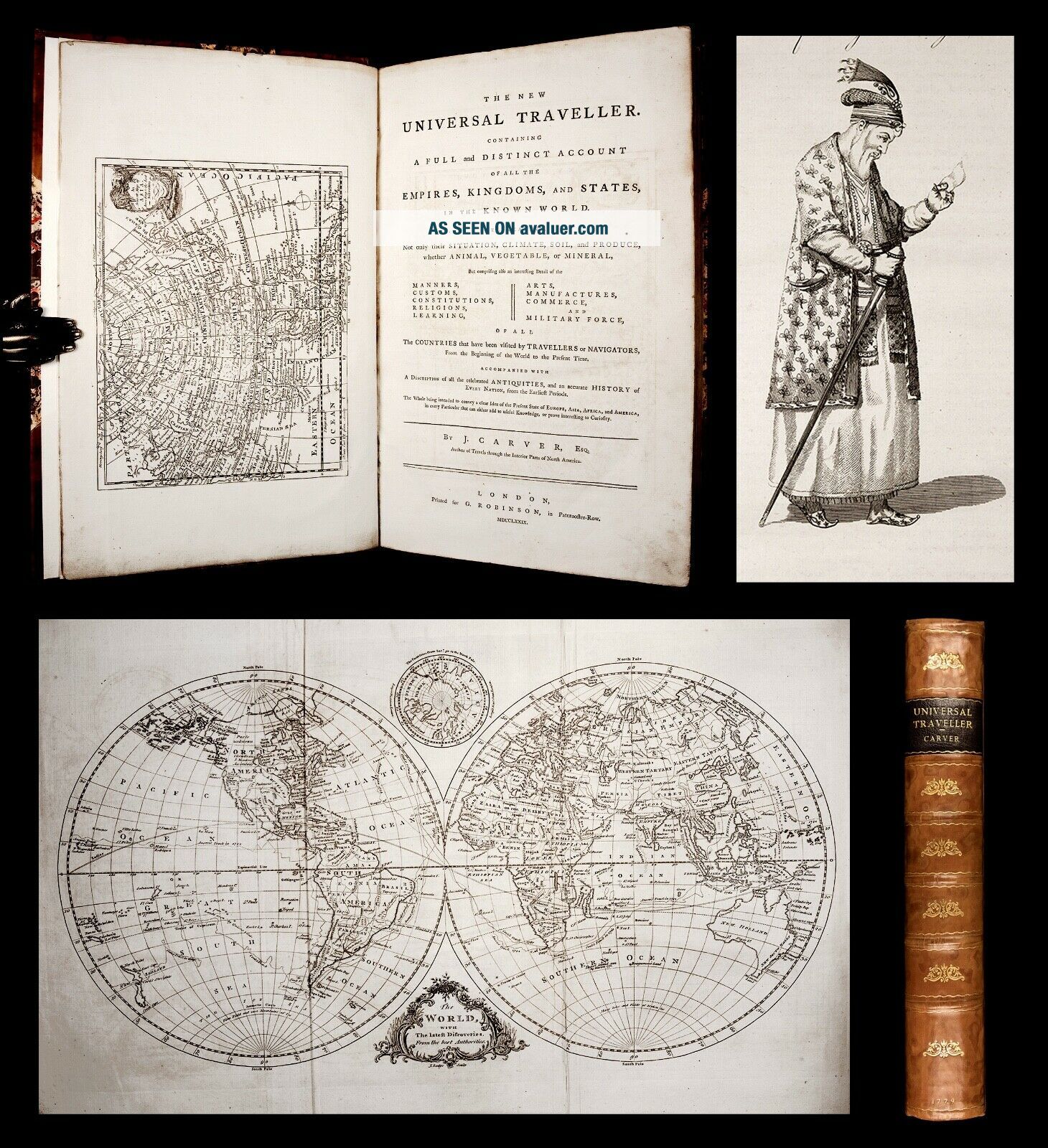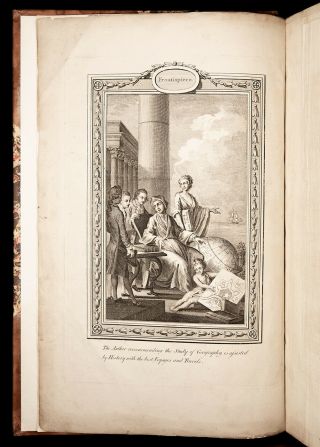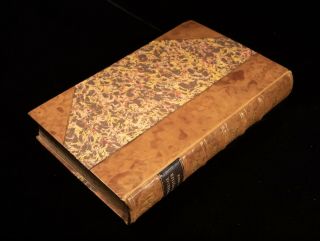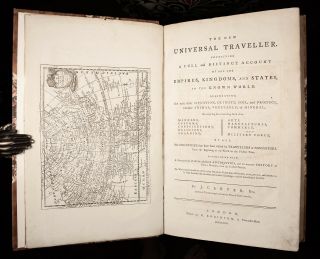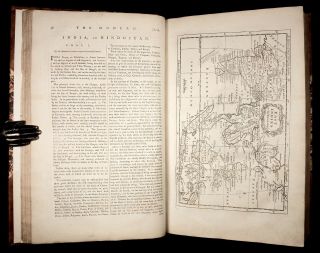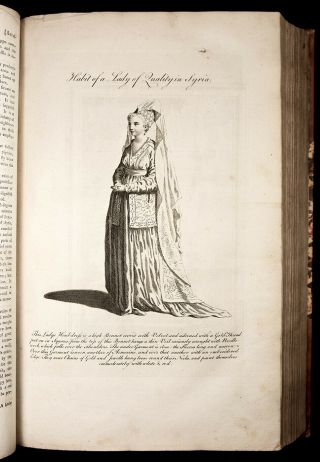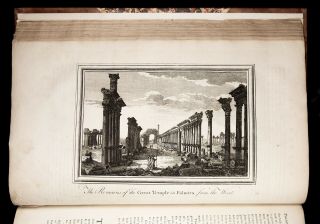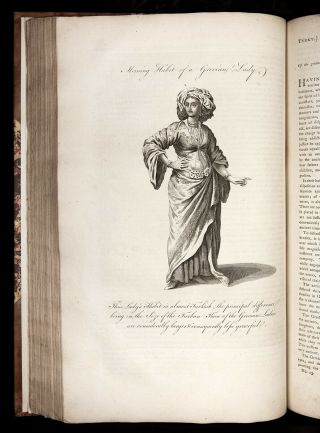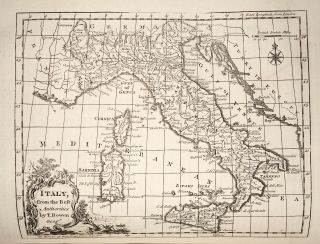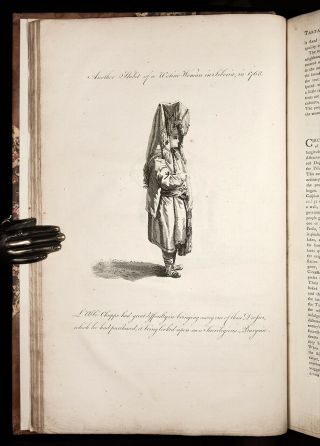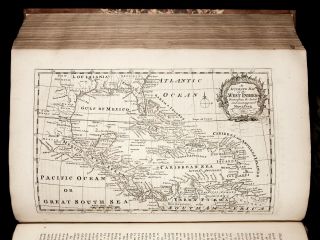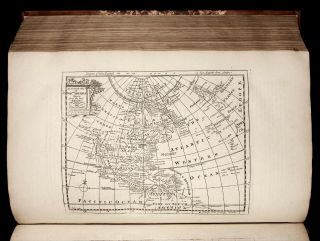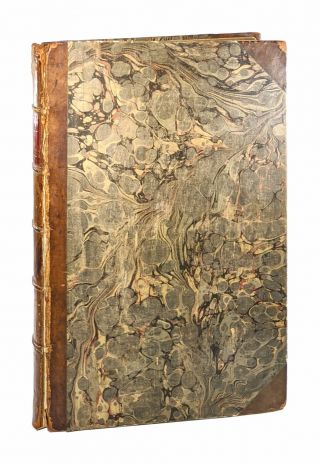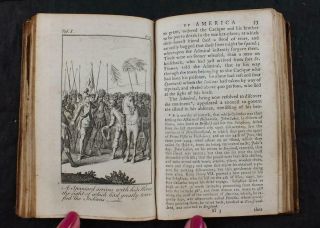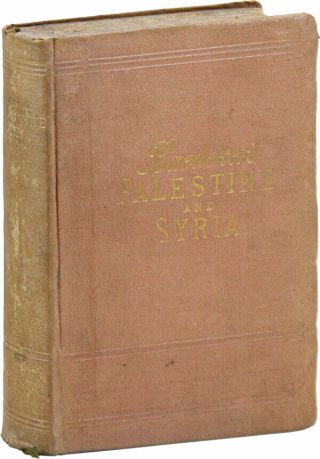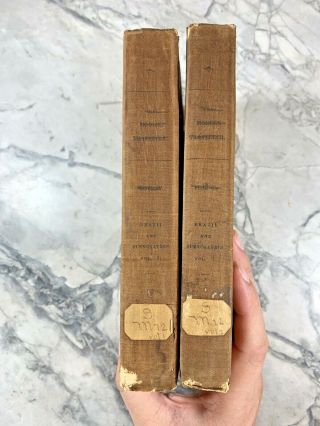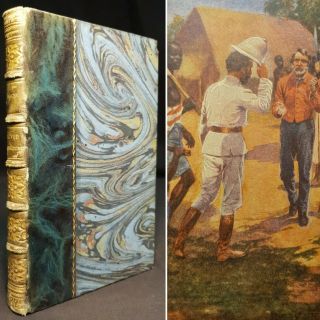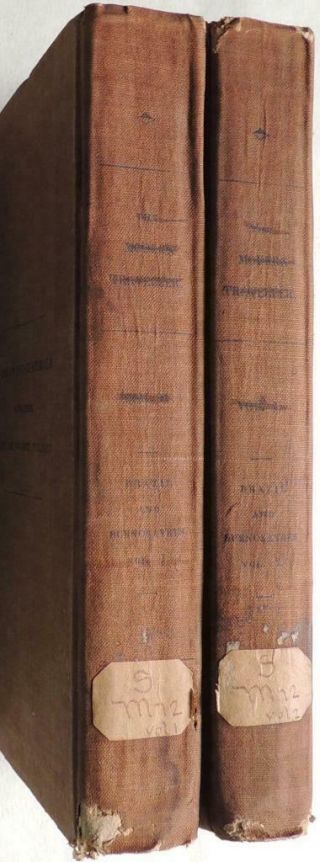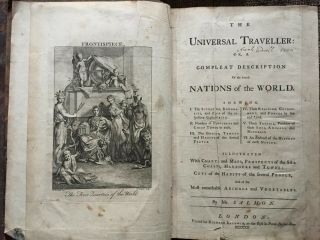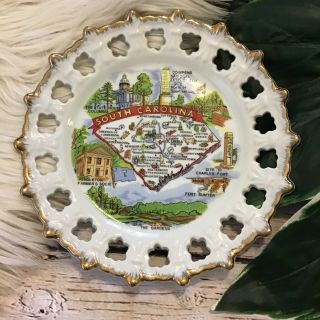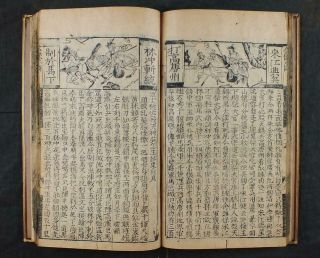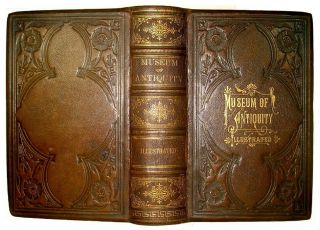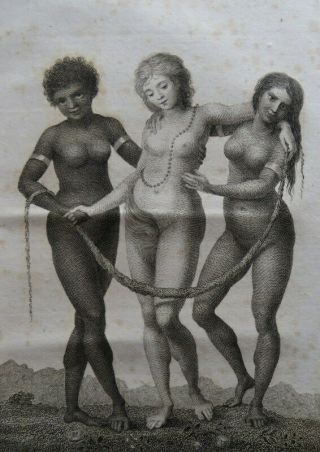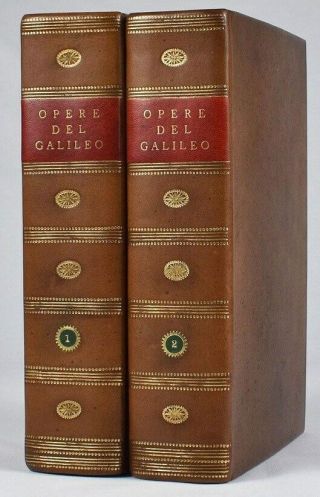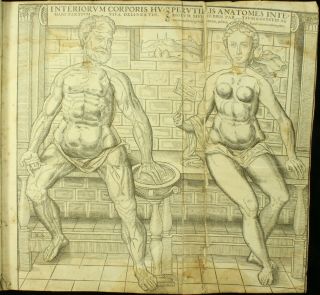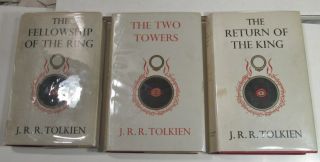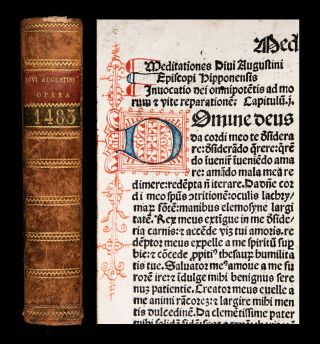1779 Carver UNIVERSAL TRAVELLER 56 Maps, Plates AMERICA China India Russia FOLIO
Item History & Price
Printed in London: for G. Robinson, 1779.
First Edition. Text in English. Illustrated with 56 engraved maps and plates.
RARE on the market! An attractive, complete example of this comprehensive geographical and ethnographic survey of the world (as known in the mid-18th century), comprising four parts dealing, respectively, with Asia (with special emphasis on China, India, Persia, and R...ussia), Africa, Europe, and America (as well as Pacific islands).The part devoted to North and South America (pages 575 - 668) includes chapters on Patagonia; Chili; Peru; Paraguay, or La Plata; Amazonia; Brazil; Old and New Mexico; California; Louisiana; Florida; Georgia; Carolina; Virginia; Maryland; Pennsylvania; New Jersey; New York; Connecticut; Rhode Island; Massachusetts Bay; New Hampshire; Nova Scotia; Canada; the Indian Nations in North America; The American Islands (including Newfoundland; Cuba; Bahamas; Bermuda; Hispaniola (St Domingo); Barbados; Grenada; Easter Island), etc.This imposing folio is illustrated with an allegorical frontispiece; 30 charming plates of costumes of various nations (Indian, Chinese, Russian, Persian, Egyptian, Grecian, Dutch, Finnish, Native American, etc.); 7 views of cities (Surat, Paris, Florence, Madrid, Jerusalem, Palmyra, Baalbec) and 18 maps, including: a folding double-hemispheric world map; North America; South America; West Indies; Asia; East Indies; Africa; Europe; Germany; Poland; Moscovy (European Russia); Sweden; France; Italy; Spain; England; Scotland; and Ireland.According to the Preface:
"That uncommon pains and attention have been bestowed on collecting information for this work, the editor can affirm with truth. Not only the writings of the most approved travellers and voyagers have been searched with great care, but oral authorities, of unquestionable credit, been consulted. The fame accuracy which has been observed in describing the present state of every country, has also been extended to a historical abstract of each." According to a contemporary review of the book, "The author begins with the account of Asia [...]. The first country, therefore, which he mentions in China, of which be gives a full, accurate, and interesting account. He observes that in the dress of the Chinese, especially the men, the ear is always left bare; and it is remarkable that among them this part of the body is universally long, broad, dangling, and of a substance rather fleshy than cartilaginous. He farther remarks, that to the custom of the ear's being constantly exposed, is probably owing the kind of deafness so common in the country, that a Chinese who has attained his fortieth year is seldom free from it. The peculiar manners of this people [are discussed in detail]; and the last chapter on [China], gives an account of the great Confucius, the religion, language, sciences, history, and character of the nation."From China the traveller proceeds to the Tartarean nations, of which he also gives a faithful and particular account; as he likewise does, afterwards, of the various islands in the Eastern ocean. Returning to the continent, he lands in the kingdom of Tonquin, whence he pursues his journey westward through Cochin-China, Siam, Pegu, Ava, Arracan, Siam, India, Persia, Arabia, and Astatic Turkey; in the course of which wide peregrination we meet with a great variety of particulars relative to the most interesting objects [...]. Mr. Carver informs us, that the Indian physicians [...] in some cases they perform extraordinary cures, particularly in the venereal disease and the bite of some species of serpents: whether this success be owing to their knowledge, and judicious application of simples, or, what seems more probable, to the abstinence generally practised in India, in every disease. Their custom and method of inoculating afford proof that in respect of the small-pox, at least, their practice is conformable to sound principles.'Inoculation', says our author, 'is performed in Hindostan by a particular tribe of Bramins, who are delegated annually for that service. The inhabitants of the different provinces, knowing the usual time of their arrival, observe strictly the regimen enjoined, whether they determine to be inoculated or not. This preparation consists only in abstaining for a month from fish, milk, and ghee, a kind of butter made generally of buffalo's milk. When the Bramins begin to inoculate, they pass from house to house, and operate at the door; refusing to perform on any person who has not strictly observed the preparatory course enjoined them. It is not unusual for them to ask the parents how many pustules they choose their children should have; and though vanity, more than well-founded confidence in their own skill, might seem to prompt such a question, we are assured by good authority, that they hardly ever exceed, or are deficient, in the number required. They inoculate indifferently on any part; but if left to their own choice, they prefer the outside of the arm, mid-way between the wrist and the elbow for the males, and the same between the elbow and shoulder for [females]. After the operation, which, a few superstitious ceremonies excepted, is performed nearly in the usual manner, the diet that bad been previously recommended, is ordered to be continued a month longer. It is likewise prescribed, that a quantity of cold water be thrown on the patient every morning and evening, till the fever supervenes; from which time this method of bathing is to be suspended, until the appearance of the eruption, when it is again to be practised in the same manner, through the subsequent course of the disease. The pustules are opened with a fine sharp-pointed thorn, as soon as they begin to change their colour, and whilst the matter continues in a fluid state. [...]'"In the account of Asiatic Turkey we observe that Mr. Carver has availed himself of the remarks made by Dr, Chandler in his travels in that country [...]. Concluding the tour of Asia at Palmyra, the author thence passes into Africa, and proceeds to the description of Egypt, which affords many interesting observations. In treating of this country, the author has very opportunely introduced an account of those fortune-tellers known by the name of gypsies.'It appears upon inquiry', says he, 'that the vagrants called gypsies, those pretended fortune-tellers that infest most countries in Europe and Asia, were originally of Egyptian extraction. In Turkey those people are called Zingances, from their captain Zingancus, who, when the sultan Selimus made a conquest of Egypt about the year 1517, with several other Mamalukes, and as many native Egyptians as refused to submit to the Turkish, yoke, retired into the deserts, where they lived by rapine, and frequently came down to the plains of Egypt, committing great outrages in the towns upon the Nile, under the dominion of the Turks. By the concourse of idle persons, who resorted to them, with the view of participating in their plunder, they increased at length to so formidable a body, that the Turks were glad to enter into a treaty with them; in which it was agreed, that they should lay down their arms, and be permitted the fame privileges which other subjects enjoyed. The Zingances, however, having been so long accustomed to a vagabond, rapacious life, and being totally unacquainted with the arts of industry, began to have recourse to their former method of subsistence. [...] Proving irreclaimable, they were formally banished [from] the kingdom, and a power was given to any man to kill a Zingance, or make him his slave, if he was found within the territories of Egypt after a limited time. Perceiving it now impossible to maintain their liberty at home, they resolved to disperse themselves into foreign countries; and that they might be able to procure a subsistence without labour, to which they had an invincible aversion, they availed themselves of the general credulity of the times, by pretending to the art of fortune-telling. This was a science in which the people of their country were vainly imagined to be proficient [...]. Soon after this period, in the reign of Henry VIII. an act of parliament passed in England, reciting: That, whereas certain outlandish people, using no craft or merchandize to live by, but going from place to place in great companies, using subtle and crafty means to deceive the king's subjects, bearing them, in hand, that they by palmestry, can tell men and women's fortunes, and so, many times subtly deceive the people of their money, and commit divers felonies and robberies: it is enacted, that all such offenders, commonly called Egyptians, who shall remain in this realm for the space of one month, shall be adjudged felons; and that every person who shall import such Egyptians, should forfeit for every offense forty pounds.'"From Egypt the traveller pursues his journey through Abyssynia, Nubia, Arrian, Zanguebar, Caffraria, Benguela, Angola, Congo, Loango, Guinea, Negroland, Zaara, Biledulgerid, Morocco, and Barbary; giving next an account of the principal islands on the coast of Africa."Quitting Africa, Mr. Carver enters Europe, where he begins with the dominions of Turkey, and thence; after giving an account of the islands, directs his course to the various nations on the continent. In this useful part of the work, we are presented with many valuable observations from the latest travellers [...]. Finishing his survey of the continent of Europe at Portugal, the traveller next proceeds to the islands in the Mediterranean, and afterwards to Great Britain. The account of the latter, particularly England and its adjacent islands, is copious and satisfactory; and in that of Scotland, we are glad to meet with the valuable observations of Mr. Pennant occasionally interspersed. The description of Scotland is succeeded by a survey of the islands of Shetland and Orkney, and afterwards of the Hebrides or Western Isles, whence the author passes over into Ireland [...]."Mr. Carver afterwards gives a distinct account of America, of the interior parts of which be has treated in a separate work. He begins his survey at the southern extremity, or Cape Horn; describing also the various provinces, manners, customs, etc of South and North America, and afterwards the islands in the West Indies and the South Seas." (The Critical Review, or Annals of Literature, Vol. 50 (December 1780), p.429-434)Although published under the name of Jonathan Carver, "the widow of Captain Carver denied [The New Universal Traveller] to be the work of her husband" (Lowndes). In fact, Carver living in poverty at that time, simply sold his name to the publisher of this work to boost the book's authority."His original works appear to have brought him scanty remuneration, and when he was constrained by poverty to sell his name to the publisher of a large folio volume in the writing of which he had borne no part, entitled 'The New Universal Traveller', his friends looked upon the transaction as dishonorable, and withdrew their countenance from his efforts to gain a maintenance." (John Thomas Lee, A Bibliography of Carver's Travels, p.92)Lee further notes that "It is quite likely that this book, which bears Carver's name, although he was not the author, was issued in weekly parts. The manner in which the sheets are numbered makes it seem probable that the work was issued in parts of 3 sheets or 12 pages each. The last 3 sheets, the index, and preface are numbered 55, which perhaps indicates that there were 55 parts in all." (ibid, p.162)Jonathan Carver (1710 - 1780) was an early explorer of North America and author of one of the most widely read travel and adventure books in that period. Born in Weymouth, Massachusetts, Carver was promoted to lieutenant (1759) and then to captain (1760) while serving in a Massachusetts regiment during the French and Indian War. In 1766 he was sent by Major Robert Rogers on a journey of exploration westward from Rogers' base at Fort Michilimackinac (now Mackinac, MI). Carver traveled west through the Great Lakes region to the Mississippi River and then up that river to the country of the Sioux Indians. Alone, he spent the winter of 1766-67 at a Sioux village on the Minnesota River. Returning to Fort in the spring, he met Captain James Tute in command of a party that had been sent out by Rogers to explore a route to the Pacific Ocean. Tute brought orders for Carver to join the party as draftsman and third in command. They proceeded up the Mississippi, but failing to receive supplies, the party abandoned the expedition and returned to Fort Michilimackinac. Carver left for England in 1769 to have his journal published, but the project met with many delays. His journal was finally published in 1778 in London as 'Travels Through the Interior Parts of North America in the Years 1766, 1767, 1768'; it was an immediate success and eventually went through more than 30 editions. Carver, however, did not live to enjoy any financial reward from it. He died n London a broken old man and was buried in a potter's field.Bibliographic references:ESTC T133709; Sabin 11183; Lowndes p.35; John Thomas Lee, A Bibliography of Carver's Travels, p.159-162.Physical description:Folio, leaves measure 36.5 cm x 23.5 cm. Bound in 20th-century light-brown half-calf over marbled boards; spine (with raised bands) tooled in gilt and with a gilt-lettered black morocco label.Pagination: [2], iii, [1], 668 (i. e., 664), [6] pages + 56 plates. COMPLETE.Illustrated with an engraved allegorical frontispiece, 18 engraved maps (including a large folding double-hemispheric world map), as well as 37 other engraved plates (of which 30 depict costumes of various nations, and 7 views of cities). Frontis, world map, and the map of Asia are bound before the title page (as required per list of plates).Main text printed in double columns.Preliminaries include a Preface, and "Directions to the Binder" (i.e. list of plates).Index occupies 6 unnumbered leaves at the end.Condition:Very Good antiquarian condition. Complete, with all plates and maps present. Some marginal toning to paper, and occasional light spotting. Some marginal soiling. Occasional light offsetting from plates. Folding map with minor edge-wear, light creasing, and a couple short closed marginal tears (image not affected at all). In all, a nice, wide-margined, solid example of this scarce, well-illustrated work in an imposing folio format.
Please right-click on thumbnails below and choose "open image in a new window" option to see larger images.



